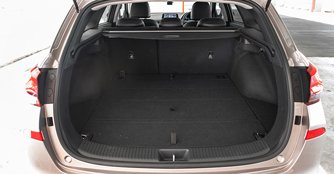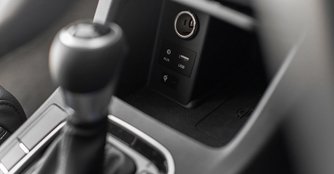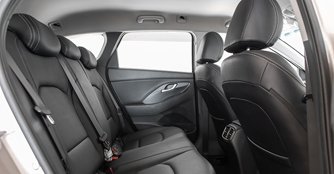Hyundai i30 Wagon 1.4 GLS DCT Turbo (A) Review
03 Sep 2018|21,588 views
What We Like
Much larger boot than the hatchback
Clever storage solutions
A little more headroom as well
Just as easy to drive boot
What We Dislike
Fuel economy is slightly worse at 10km/L but is still a reasonable figure
Less sporty-looking than the hatchback
Unless you have an extreme bias towards its design, there is little reason to prefer the hatchback to the wagon version of the new Hyundai i30.
That's because for just five grand more, the i30 Wagon offers almost twice the amount of boot space with the rear seats up (602 litres versus 395 litres) and 349 litres more in two-seater configuration.
It also comes with compartmented storage beneath the boot floor, a tonneau cover and a safety net for you to stow smaller items away neatly.

 There's a generous 602 litres of boot space on offer even without having to fold the rear seats down
There's a generous 602 litres of boot space on offer even without having to fold the rear seats down
And that's just the tip of the iceberg. While the wheelbases of both i30 models remain the same at 2,650mm, the i30 Wagon also offers a little more headroom in the rear, as well as five more airbags for added safety.
Like in the hatchback, it is nicely built and well equipped for a car listed at $100,999 (as of 30th August 2018). Materials used throughout the cabin are of better quality than Hyundai models of yesteryear, while the seats provide an ample of amount of comfort and support.

 USB connectivity as well as wireless phone charging are some of the handy features that come standard
USB connectivity as well as wireless phone charging are some of the handy features that come standard
Elsewhere, a 9.0-inch touchscreen infotainment system with USB and Bluetooth connectivity, rear air-conditioning, an electric parking brake with auto hold and a reverse camera are offered as standard equipment.
A little heavier but no less capable
With its added space, the i30 Wagon is about 54kg heavier than the hatchback. But on the go, that extra weight is negligible.
That's because for just five grand more, the i30 Wagon offers almost twice the amount of boot space with the rear seats up (602 litres versus 395 litres) and 349 litres more in two-seater configuration.
It also comes with compartmented storage beneath the boot floor, a tonneau cover and a safety net for you to stow smaller items away neatly.

And that's just the tip of the iceberg. While the wheelbases of both i30 models remain the same at 2,650mm, the i30 Wagon also offers a little more headroom in the rear, as well as five more airbags for added safety.
Like in the hatchback, it is nicely built and well equipped for a car listed at $100,999 (as of 30th August 2018). Materials used throughout the cabin are of better quality than Hyundai models of yesteryear, while the seats provide an ample of amount of comfort and support.

Elsewhere, a 9.0-inch touchscreen infotainment system with USB and Bluetooth connectivity, rear air-conditioning, an electric parking brake with auto hold and a reverse camera are offered as standard equipment.
A little heavier but no less capable
With its added space, the i30 Wagon is about 54kg heavier than the hatchback. But on the go, that extra weight is negligible.
It is powered by the same perky turbocharged 1.4-litre engine, paired to the same quick-shifting seven-speed dual-clutch transmission as in the hatchback, outputting 138bhp and 242Nm of torque.
On paper, Hyundai says the i30 Wagon is 0.3 seconds slower from 0-100km/h but the difference in acceleration is so insignificant you won't ever feel it.
Even in corners, the i30 Wagon does not feel any less capable than its smaller-sized sibling despite its jutted rear overhangs.
Its well-weighted steering and well-damped suspension allow you to make quick directional changes without fuss, while also gliding over tarmac in the similar sort of fashion more expensive European cars do.
But wait, there is one tiny drawback
The only noticeable difference, then, would be its fuel economy, which clocks in at 10km/L, a drop from the hatchback's 13.5km/L. Still, it is an inconsequential trade-off.
If you have a good nose for value, you will be hard-pressed to pick the hatchback over the wagon, even if it does look more stylish from the side.
On paper, Hyundai says the i30 Wagon is 0.3 seconds slower from 0-100km/h but the difference in acceleration is so insignificant you won't ever feel it.
Even in corners, the i30 Wagon does not feel any less capable than its smaller-sized sibling despite its jutted rear overhangs.
Its well-weighted steering and well-damped suspension allow you to make quick directional changes without fuss, while also gliding over tarmac in the similar sort of fashion more expensive European cars do.
But wait, there is one tiny drawback
The only noticeable difference, then, would be its fuel economy, which clocks in at 10km/L, a drop from the hatchback's 13.5km/L. Still, it is an inconsequential trade-off.
If you have a good nose for value, you will be hard-pressed to pick the hatchback over the wagon, even if it does look more stylish from the side.
What We Like
Much larger boot than the hatchback
Clever storage solutions
A little more headroom as well
Just as easy to drive boot
What We Dislike
Fuel economy is slightly worse at 10km/L but is still a reasonable figure
Less sporty-looking than the hatchback
Unless you have an extreme bias towards its design, there is little reason to prefer the hatchback to the wagon version of the new Hyundai i30.
That's because for just five grand more, the i30 Wagon offers almost twice the amount of boot space with the rear seats up (602 litres versus 395 litres) and 349 litres more in two-seater configuration.
It also comes with compartmented storage beneath the boot floor, a tonneau cover and a safety net for you to stow smaller items away neatly.

 There's a generous 602 litres of boot space on offer even without having to fold the rear seats downAnd that's just the tip of the iceberg. While the wheelbases of both i30 models remain the same at 2,650mm, the i30 Wagon also offers a little more headroom in the rear, as well as five more airbags for added safety.
There's a generous 602 litres of boot space on offer even without having to fold the rear seats downAnd that's just the tip of the iceberg. While the wheelbases of both i30 models remain the same at 2,650mm, the i30 Wagon also offers a little more headroom in the rear, as well as five more airbags for added safety.
Like in the hatchback, it is nicely built and well equipped for a car listed at $100,999 (as of 30th August 2018). Materials used throughout the cabin are of better quality than Hyundai models of yesteryear, while the seats provide an ample of amount of comfort and support.


USB connectivity as well as wireless phone charging are some of the handy features that come standardElsewhere, a 9.0-inch touchscreen infotainment system with USB and Bluetooth connectivity, rear air-conditioning, an electric parking brake with auto hold and a reverse camera are offered as standard equipment.
A little heavier but no less capable
With its added space, the i30 Wagon is about 54kg heavier than the hatchback. But on the go, that extra weight is negligible.
That's because for just five grand more, the i30 Wagon offers almost twice the amount of boot space with the rear seats up (602 litres versus 395 litres) and 349 litres more in two-seater configuration.
It also comes with compartmented storage beneath the boot floor, a tonneau cover and a safety net for you to stow smaller items away neatly.

Like in the hatchback, it is nicely built and well equipped for a car listed at $100,999 (as of 30th August 2018). Materials used throughout the cabin are of better quality than Hyundai models of yesteryear, while the seats provide an ample of amount of comfort and support.

USB connectivity as well as wireless phone charging are some of the handy features that come standard
A little heavier but no less capable
With its added space, the i30 Wagon is about 54kg heavier than the hatchback. But on the go, that extra weight is negligible.
It is powered by the same perky turbocharged 1.4-litre engine, paired to the same quick-shifting seven-speed dual-clutch transmission as in the hatchback, outputting 138bhp and 242Nm of torque.
On paper, Hyundai says the i30 Wagon is 0.3 seconds slower from 0-100km/h but the difference in acceleration is so insignificant you won't ever feel it.
Even in corners, the i30 Wagon does not feel any less capable than its smaller-sized sibling despite its jutted rear overhangs.
Its well-weighted steering and well-damped suspension allow you to make quick directional changes without fuss, while also gliding over tarmac in the similar sort of fashion more expensive European cars do.
But wait, there is one tiny drawback
The only noticeable difference, then, would be its fuel economy, which clocks in at 10km/L, a drop from the hatchback's 13.5km/L. Still, it is an inconsequential trade-off.
If you have a good nose for value, you will be hard-pressed to pick the hatchback over the wagon, even if it does look more stylish from the side.
On paper, Hyundai says the i30 Wagon is 0.3 seconds slower from 0-100km/h but the difference in acceleration is so insignificant you won't ever feel it.
Even in corners, the i30 Wagon does not feel any less capable than its smaller-sized sibling despite its jutted rear overhangs.
Its well-weighted steering and well-damped suspension allow you to make quick directional changes without fuss, while also gliding over tarmac in the similar sort of fashion more expensive European cars do.
But wait, there is one tiny drawback
The only noticeable difference, then, would be its fuel economy, which clocks in at 10km/L, a drop from the hatchback's 13.5km/L. Still, it is an inconsequential trade-off.
If you have a good nose for value, you will be hard-pressed to pick the hatchback over the wagon, even if it does look more stylish from the side.
Car Information
Hyundai i30 Wagon 1.4 GLS DCT Turbo (A)
CAT B|Petrol|18.2km/L
Horsepower
103kW (138 bhp)
Torque
242 Nm
Acceleration
9.5sec (0-100km /hr)
This model is no longer being sold by local distributor
All Used Hyundai i30 WagonThank You For Your Subscription.








































